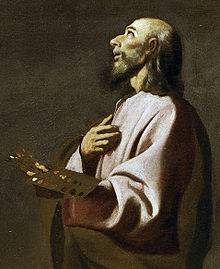This painting was started by Francisco de Zurbarán in
1655. The painting was for the “Painters Professional Asociation” of Seville. It
was painted in Seville, one year later after Zurbarán’s arrival to the city. It
was commissioned by the Fine Arts Museum of Seville.

Source: http://blogs.artinfo.com/secrethistoryofart/2011/03/02/inside-the-masterpiece-zurbarans-saint-hugo-in-the-refectory/
This painting has a size of 267x320 cm. The material
used is oil painting, technique that was predominant in the Baroque. The
painting is found in the Fine Arts Museum in Seville.
This painting represents a miracle that happened in
the Carthusian Refectory. They were seven, and Saint Bruno was the founder of
the Carthusian and they all ate due to Saint Hugo’s (bishop of Grenoble)
generosity. One Sunday, he sent them meat. Like they weren’t used to eat meat,
this brought them to a discussion of the abstinence, and while they arguing
they all became asleep. This dream lasted all the Lent, till the third day of
the Holy Week, the Wednesday. That day, the Carthusian woke up and Saint Hugo
visited them, and then suddenly, the meat transformed into ashes. This moment
is interpreted like an approbation of the abstinence of meat.
As this painting is baroque it presents the following
characteristics:
- · Use of oil painting. This painting is made with oil painting only.
- · Predominance of colour over drawing. We can observate a lot of colour in this Zurbarán’s painting, just the opposite as in Renaissance Art.
- · Warm colours, contrast, realism, movement, complex competitons to stoch the audience. We perceive the sensation of movement in the painting, and also we perceive the absence of cold colours: they’re all warm. Realism is also present, and that imply the sensation of movement.
Another interesting information is that the White
Colour of the Carthusian’s clothes reaches 100 different hues.
Here you have a portrait of Francisco de Zurbarán:

Source: http://es.wikipedia.org/wiki/Francisco_de_Zurbar%C3%A1n
My encyclopedia of art.
Hello Alfredo,
ReplyDeleteYour analysis is too general: you can't write the Baroque features without explaining where they appear in the painting: where is the complex composition? Where are the warm colours? I don't think white is a warm colour.
These are my corrctions:
- for the “Painters Professional Association” of Seville. It was painted in Seville, one year later after Zurbarán’s arrival to the city. It (was commissioned by) is exhibited in the Fine Arts Museum of Seville.
- The material used is oil painting on canvas,
- They were seven monks, and Saint Bruno was the founder of the Carthusian and they all ate due to Saint Hugo’s (bishop of Grenoble) generosity. One Sunday, he sent them meat. As they weren’t used to eat meat, this brought them to a discussion of the abstinence, and while they were arguing, they all became asleep. This dream lasted all the Lent, till the third day of the Holy Week, the Wednesday. That day, the Carthusians woke up
- As this painting is baroque, it presents the following characteristics:
- Predominance of colour over drawing. We can observe a lot of colour in this Zurbarán’s painting, just the opposite to Renaissance Art.
-...realism, movement, complex composition to shock the audience. We perceive the sensation of movement in the painting, and also we perceive the absence of cold colours: they’re all warm. Realism is also present, and that implies the sensation of movement.
- Another interesting piece of information is that the White Colour of the Carthusian’s clothes reaches 100 different hues.
Your mark is 7. Bye.